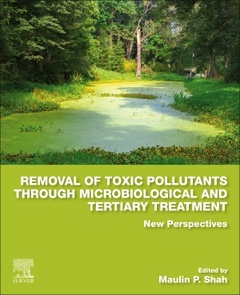Removal of Toxic Pollutants through Microbiological and Tertiary Treatment New Perspectives
Coordonnateur : Shah Maulin P.

Removal of Toxic Pollutants through Microbiological and Tertiary Treatment: New Perspectives offers a current account of existing advanced oxidation strategies - including their limitations, challenges, and potential applications - in removing environmental pollutants through microbiological and tertiary treatment methods. The book introduces new trends and advances in environmental bioremediation technology, with thorough discussion of recent developments in the field. Updated information as well as future research directions in the field of bioremediation of industrial wastes is included. This book is an indispensable guide to students, researchers, scientists, and professionals working in fields such as microbiology, biotechnology, environmental sciences, eco-toxicology, and environmental remediation.
The book also serves as a helpful guide for waste management professionals and those working on the biodegradation and bioremediation of industrial wastes and environmental pollutants for environmental sustainability.
1. Bioremediation of Organic and Metal Co-contaminated Environments through various microbiological and advanced tertiary treatment technologies2. New Bioremediation Technologies to Remove Metal (loids) and Radionuclides through various microbiological and advanced tertiary treatment technologies3. Bioremediation of Soils Polluted with Hexavalent Chromium using Bacteria through various microbiological and advanced tertiary treatment technologies4. Accumulation and Detoxification of Metal(loid)s by Plants and Microbes through various microbiological and advanced tertiary treatment technologies5. Metal (loid) s Resistance in Plants through different treatment technologies6. Bioremediation of Metals by biological and tertiary treatment methods7. Phytoremediation of Metal (loids) and Radionuclides8. Nanotechnology for Bioremediation of Heavy Metal(loid)s9. Nitrate Pollution and its Remediation10. Bioremediation of Petroleum Sludge11. Diversity, Biodegradation and Bioremediation of Polycyclic Aromatic Hydrocarbons12. Environmental Applications of Fungal and Plant Systems13. Fungal-Based Remediation14. Biofilms in Porous Media15. Emerging technologies on Nanotechnology, Micro plastic degradation, Antibiotics16.Case Study17. Applications of bioinformatics and computational tools in environmental genomics and bioremediation of environmental pollutants18. Field experience of Bioremediation and phytoremediation: Success stories and realism
Dr. Maulin P. Shah is Chief Scientist and Head of the Industrial Waste Water Research Lab, Division of Applied and Environmental Microbiology Lab at Enviro Technology Ltd., Ankleshwar, Gujarat, India. His work focuses on the impact of industrial pollution on the microbial diversity of wastewater following cultivation-dependent and cultivation-independent analysis. His major work involves isolation, screening, identification, and genetically engineering high-impact microbes for the degradation of hazardous materials. His research interests include biological wastewater treatment, environmental microbiology, biodegradation, bioremediation, and phytoremediation of environmental pollutants from industrial wastewaters.
- Introduces various treatment schemes, including microbiological and tertiary technologies for bioremediation of environmental pollutants and industrial wastes
- Includes pharmaceutical wastewater, oil refinery wastewater, distillery wastewater, tannery wastewater, textile wastewater, mine tailing wastes, plastic wastes, and more
- Describes the role of relatively new treatment technologies and their approaches in bioremediation, including molecular and protein engineering technologies, microbial enzymes, bio surfactants, plant-microbe interactions, and genetically engineered organisms
- Provides many advanced technologies in the field of bioremediation and phytoremediation, including electro-bioremediation technology, microbial fuel cell technology, nano-bioremediation technology, and phytotechnologies
Date de parution : 08-2020
Ouvrage de 620 p.
19x23.3 cm
Thème de Removal of Toxic Pollutants through Microbiological and... :
Mots-clés :
Adsorption; Advanced oxidation pocesses; Advanced oxidation process; Aerobic digestion; Aerobic process; Anaerobic process; Antibiotic resistance genes; Antibiotics; Anticancer activity; Antimicrobial Activity; AOPs; Arsenic; Bacteria; Bioassimilation; Bioaugmentation; Biodegradation; Biodiversity; Bioindicators; Biological treatment; Biomass; Bioremediation; Biosorption; Biostimulation; Bleaching process; Chromium; Consortia development; Conventional wastewater treatment; Debarking; Degradation; Degradation pathways; Dendrimers; Drug delivery; Dry yeast; Dye-decolorizing peroxidase; Dyes; Ecology; Ecosystem; Ecotoxicity; Emerging pollutants; Endocrine disruptor; Environment; Fenton process; Fixed and fluidized bed reactors; Heavy metal; Heme; Hydrocarbon; Hydroxyl; Leachate; Lead; Lignin degradation; Mammals; Medical applications; Membrane distillation; Membrane filtration; Membrane technologies; Mercury; Metagenomics; Metatranscriptomics; MFC; Microalgae; Microalgal-Bacterial consortium; Microfiltration; Microorganisms; Micropollutants; Municipal solid waste; Nanobiotechnology; Nanocatalyst; Nanomaterials; Nanomedicine; Nanotechnology; Nitrate; Omics approach; Oxidoreductase; Pathogenic microorganisms; Petroleum hydrocarbons; Pharmaceutical pollutant; Pharmaceutical wastewater; Phthalate exposure; Pollutants; Pulp making process; Remediation; RO; Sludge; Substrate; Surface modification; Synthetic dyes; Tertiary treatment technologies; Toxic effects; Toxic pollutants; Toxicity; VSS; Wastewater; Wastewater treatment; Water; Water treatment; Zero-valent iron (ZVI)



